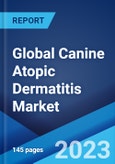The global canine atopic dermatitis market size reached US$ 1.8 Billion in 2022. Looking forward, the market is expected to reach US$ 4.4 Billion by 2028, exhibiting a growth rate (CAGR) of 16.06% during 2022-2028.
Canine atopic dermatitis (CAD) is an allergic skin disease in dogs caused by allergens, such as pollens, house dust, insect bites, grass and food ingredients. It is an inherited predisposition that generally affects dogs aged between six months to three years. It commonly affects the ventral abdomen, mouth, eyes, interdigital skin, ear pinnae, carpal, elbow and perineal area of the animals. CAD is characterized by various symptoms, such as excessive scratching, inflammation and itching around paws, underarms and face. It can be treated by immuno-suppressants, monoclonal anatomy and glucocorticoids. They can be administered through oral, injectables and topical medications. It is known to be highly prevalent in German shepherds, Labradors, golden retrievers and pugs.
Canine atopic dermatitis (CAD) is an allergic skin disease in dogs caused by allergens, such as pollens, house dust, insect bites, grass and food ingredients. It is an inherited predisposition that generally affects dogs aged between six months to three years. It commonly affects the ventral abdomen, mouth, eyes, interdigital skin, ear pinnae, carpal, elbow and perineal area of the animals. CAD is characterized by various symptoms, such as excessive scratching, inflammation and itching around paws, underarms and face. It can be treated by immuno-suppressants, monoclonal anatomy and glucocorticoids. They can be administered through oral, injectables and topical medications. It is known to be highly prevalent in German shepherds, Labradors, golden retrievers and pugs.
Canine Atopic Dermatitis Market Trends
The increasing occurrence of CAD in domesticated dogs across the globe is one of the key factors creating a positive outlook for the market. This can be attributed to the changing environmental conditions, rising air pollution levels and prolonged exposure to allergens. Moreover, the increasing concerns and rising awareness among pet owners regarding early symptoms and signs of CAD, such as redness, greasy skin and yeasty smell, are providing a thrust to the market growth. Additionally, the widespread adoption of monoclonal antibodies for the treatment of the disease is favoring the market growth. These antibodies aid in directing the required immune response and calming the spread of the disease. In line with this, the increasing number of veterinary practitioners, hospitals and clinics dedicated to providing improved care for animals is positively impacting the market growth. Other factors, including the implementation of various government initiatives to restrict the usage of off-label human drugs on animals, along with extensive research and development (R&D) in the field of veterinary sciences, are anticipated to drive the market toward growth.Key Market Segmentation
This research provides an analysis of the key trends in each sub-segment of the global canine atopic dermatitis market report, along with forecasts at the global, regional and country level from 2023-2028. The report has categorized the market based on drug class type, route of administration and distribution channel.Breakup by Drug Class Type:
- Glucocorticoids
- Immunosuppressants
- Monoclonal Antibody
Breakup by Route of Administration:
- Topical
- Oral
- Injectable
Breakup by Distribution Channel:
- Veterinary Hospitals
- Pet Clinics
- Pharmacies and Drugstores
Breakup by Region:
- North America
- United States
- Canada
- Asia-Pacific
- China
- Japan
- India
- South Korea
- Australia
- Indonesia
- Europe
- Germany
- France
- United Kingdom
- Italy
- Spain
- Russia
- Latin America
- Brazil
- Mexico
- Middle East and Africa
Competitive Landscape
The competitive landscape of the industry has also been examined along with the profiles of the key players being AB Science, Bimeda Inc., Bioceltix SA, Boehringer Ingelheim International GmbH, Ceva Santé Animale, Dechra Pharmaceuticals PLC, Elanco Animal Health Incorporated, Phibro Animal Health Corporation, Toray Industries Inc., Vetoquinol S.A., Virbac and Zoetis Inc.Key Questions Answered in This Report:
- How has the global canine atopic dermatitis market performed so far and how will it perform in the coming years?
- What has been the impact of COVID-19 on the global canine atopic dermatitis market?
- What are the key regional markets?
- What is the breakup of the market based on the drug class type?
- What is the breakup of the market based on the route of administration?
- What is the breakup of the market based on the distribution channel?
- What are the various stages in the value chain of the industry?
- What are the key driving factors and challenges in the industry?
- What is the structure of the global canine atopic dermatitis market and who are the key players?
- What is the degree of competition in the industry?
Table of Contents
1 Preface3 Executive Summary11 Value Chain Analysis13 Price Analysis
2 Scope and Methodology
4 Introduction
5 Global Canine Atopic Dermatitis Market
6 Market Breakup by Drug Class Type
7 Market Breakup by Route of Administration
8 Market Breakup by Distribution Channel
9 Market Breakup by Region
10 SWOT Analysis
12 Porters Five Forces Analysis
14 Competitive Landscape
Companies Mentioned
- AB Science
- Bimeda Inc.
- Bioceltix SA
- Boehringer Ingelheim International GmbH
- Ceva Santé Animale
- Dechra Pharmaceuticals PLC
- Elanco Animal Health Incorporated
- Phibro Animal Health Corporation
- Toray Industries Inc.
- Vetoquinol S.A.
- Virbac
- Zoetis Inc.
Methodology

LOADING...
Table Information
| Report Attribute | Details |
|---|---|
| No. of Pages | 145 |
| Published | November 2023 |
| Forecast Period | 2022 - 2028 |
| Estimated Market Value ( USD | $ 1.8 Billion |
| Forecasted Market Value ( USD | $ 4.4 Billion |
| Compound Annual Growth Rate | 16.1% |
| Regions Covered | Global |
| No. of Companies Mentioned | 12 |









